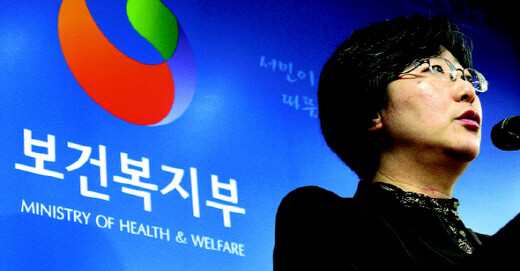hankyoreh
Links to other country sites 다른 나라 사이트 링크
First fatality from Creutzfeldt-Jakob disease confirmed

By Kim Yang-joong, Medical Correspondent
Heath officials confirmed the death of a woman who is South Korea’s victim of Creutzfeldt-Jakob disease (CJD), one of its four variants more commonly known as “mad cow disease.”
Health officials believe she contracted CJD from transplanted meninges following surgery to remove a tumor in the membrane surrounding her brain. CJD is a degenerative brain disease that causes symptoms including dementia and impaired motor capacity. It is caused when varieties of protein called prions destroy brain tissue. There are four types of CJD, each with a different cause.
The Center for Disease Control (CDC) and a team from Hallym University Medical Center led by Professor Kim Yun-jong examined the brain tissue of a 54-year-old woman who began displaying symptoms such as sensory abnormalities, impaired motor capacity and mental abnormalities in June last year and died last month. They then conducted animal tests to confirm the cause of the woman’s death. These revealed the cause to have been iatrogenic Creutzfeldt-Jakob disease (iCJD), CJD contracted as a result of medical treatment. Yesterday’s statement claimed that this was the first confirmed case of its kind in South Korea.
The deceased woman received a transplanted membrane manufactured in Germany under the brand Lyodura in 1987, following surgery to remove a tumor. In June last year, when her brain began displaying abnormal symptoms, she underwent MRI, brain wave and brain tissue tests and it was confirmed that she had contracted CJD. The disease had emerged 23 years after her operation. The patient was at first suspected to have contracted sporadic CJD (sCJD), which occurs naturally, but the investigation by Kim and others confirmed Lyodura, the transplanted membrane, to have caused the disease, leading to its categorization as CJD contracted in the process of medical treatment.
Around 400 cases of CJD contracted in the process of medical treatment have been reported in 20 countries around the world. Among these, around 200 cases broke out following brain tissue transplants.
“The German-made brain tissue that caused the problem is presumed to have been taken from the cadaver of another patient that had been infected with naturally occurring sporadic CJD,” said Park Hye-kyung, in charge of contagious disease management at the CDC. “The probability that she contracted CJD after the operation is around 0.05-2%.”
Such German-made brain tissue is no longer used. This is because the manufacturer has been using a prion deactivation process since the first reported case of CJD was reported in the United States in 1987.
Please direct questions or comments to [englishhani@hani.co.kr]
Editorial・opinion
![[Column] Has Korea, too, crossed the Rubicon on China? [Column] Has Korea, too, crossed the Rubicon on China?](https://flexible.img.hani.co.kr/flexible/normal/500/300/imgdb/original/2024/0419/9317135153409185.jpg) [Column] Has Korea, too, crossed the Rubicon on China?
[Column] Has Korea, too, crossed the Rubicon on China?![[Correspondent’s column] In Japan’s alliance with US, echoes of its past alliances with UK [Correspondent’s column] In Japan’s alliance with US, echoes of its past alliances with UK](https://flexible.img.hani.co.kr/flexible/normal/500/300/imgdb/original/2024/0419/2317135166563519.jpg) [Correspondent’s column] In Japan’s alliance with US, echoes of its past alliances with UK
[Correspondent’s column] In Japan’s alliance with US, echoes of its past alliances with UK- [Editorial] Does Yoon think the Korean public is wrong?
- [Editorial] As it bolsters its alliance with US, Japan must be accountable for past
- [Guest essay] Amending the Constitution is Yoon’s key to leaving office in public’s good graces
- [Editorial] 10 years on, lessons of Sewol tragedy must never be forgotten
- [Column] A death blow to Korea’s prosecutor politics
- [Correspondent’s column] The US and the end of Japanese pacifism
- [Guest essay] How Korea turned its trainee doctors into monsters
- [Guest essay] As someone who helped forge Seoul-Moscow ties, their status today troubles me
Most viewed articles
- 1[Column] The clock is ticking for Korea’s first lady
- 2After 2 months of delayed, denied medical care, Koreans worry worst may be yet to come
- 3Hong Se-hwa, voice for tolerance whose memoir of exile touched a chord, dies at 76
- 4[Column] Has Korea, too, crossed the Rubicon on China?
- 5US overtakes China as Korea’s top export market, prompting trade sanction jitters
- 6Samsung barricades office as unionized workers strike for better conditions
- 7[Editorial] As it bolsters its alliance with US, Japan must be accountable for past
- 8[Correspondent’s column] In Japan’s alliance with US, echoes of its past alliances with UK
- 9All eyes on Xiaomi after it pulls off EV that Apple couldn’t
- 10[Correspondent’s column] The US and the end of Japanese pacifism